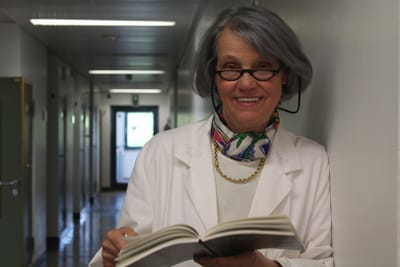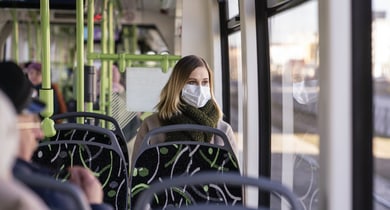
‘Disease outbreaks tend to be swept under the carpet at first’
What viruses are particularly dangerous to humans? And how likely are further pandemics in future? In her interview with Daniel Schriber, the virologist Karin Moelling explains why the virus that causes COVID-19 was able to spread so quickly – and why we are unlikely to be able to prevent similar outbreaks in future.
Karin Moelling, are viruses a bad thing?
Viruses should not be viewed negatively. We tend to think of them as pathogens only, but viruses are an important part of life. They are a part of our genetic make-up and drive evolution; for example, our cells learn from them how to fight other viruses. We would not be alive without viruses.
Thankfully, not all viruses are as devastating as the COVID-19 virus. What factors determine whether a pandemic has dramatic consequences?
Only viruses that can pass between humans are dangerous. Some viruses ‘learn’ to do that over time; viruses that are adapted to human cells – for example, out of curiosity in a lab – pose a particular threat. To this day, we do not know if laboratory work contributed to the high transmission rate of the COVID-19 virus, but it is clear that the virus is 10 times more contagious than influenza. Prevention of its spread immediately would have been extremely important. Early detection and immediate measures are decisive.

Virology professor Karin Moelling received the Swiss Award for her research into fighting AIDS.
Why did those fail?
Most virus outbreaks are not detected in the beginning, or are kept quiet in the hope and expectation that they will be contained. Their subsequent spread is greatly influenced by two factors: density of people – e.g. at football matches or similar events – and a high frequency of travel. These phenomena spread viruses across the world within a short period of time.
‘Over the past decades, population density and travel have both increased enormously, so we have to expect a situation such as the current one to recur much faster than it would have done in the past.’
How high is the risk of another such pandemic event?
Not all viruses can cause a pandemic. Coronaviruses and influenza viruses are particularly well-suited to do so. We know that a local outbreak of an influenza virus leaves many people immune for several years, so that another epidemic does not emerge immediately. However, waning immunity can cause new pandemics. Over the past decades, population density and travel have both increased enormously, so we have to expect a situation such as the current one to recur much faster than it would have done in the past.
Coronaviruses have been around for a long time. Why did a pandemic only happen recently?
There has, in fact, been a coronavirus pandemic before. It took place around 1890-1896 and was called the Russian flu. The pandemic spread through the world via the railways, also occurred in several waves and cost one million people their lives. The fact that it was most likely a coronavirus has only recently become known. Today, more than a century later, the virus behind the Russian flu is one of many normal, harmless winter viruses that cause just a cold.
Are there currently any other viruses in circulation that pose a similar danger?
Yes, the influenza viruses also pose that risk. In fact, researchers expected a new pandemic to be caused by influenza rather than corona.
What conditions are necessary for an effective pandemic response?
The prevention and prediction of such events is one of the core tasks of the World Health Organization. The latter point is particularly important: the sooner we know about potentially threatening viruses, the better.
Are there other critical factors?
A virus that has been adapted to human cells poses a particular danger; this can happen, for example, during gain-of-function (GOF) research to predict particularly threatening viruses. Most laboratories modify viruses; for instance, in order to treat cancer with gene therapy viruses. However, some dangerous viruses and certain experiments should be taboo, including adaptation of viruses to human cells or animals. No journal should be allowed to publish GOF data, then scientists would stop this sort of research. After all, research depends on publications for its funding.
How can you monitor coronaviruses and other dangerous viruses?
The WHO has achieved excellent results in the past; for example, with HIV and SARS‑CoV‑1. But the organisation seems to have failed with SARS‑CoV‑2. Germany now has a new digital platform, ‘Covradar’, which helps scientists monitor coronavirus mutations and detect new mutations. A monitoring system for influenza already exists. Monitoring of viruses is difficult, because many are mostly harmless to begin with.
‘We live in metropolises, we love mass events, we travel. When it comes to pandemics, we are the perpetrators before we are the victims.’
What can we do to prevent future pandemics?
Little. We live in metropolises, we love mass events, we travel. When it comes to pandemics, we are the perpetrators before we are the victims.
So we are essentially powerless?
Monitoring is important. It is difficult, but we are better at it than we have ever been. But everyone needs to do their part: researchers, politicians, medical professionals, public authorities, really everyone.
Risks facing Switzerland
The Federal Office for Civil Protection FOCP put together a risk report that sets out the risks facing Switzerland. They include natural disasters of every kind, large-scale cyber-attacks, pandemics and electricity shortages. These high-level risks pose a challenge for insurers because it is not possible to provide comprehensive coverage for them in purely commercial terms. The potential for damage exceeds insurers’ capacity. In addition, the damages are not independent of each other, occurring simultaneously. This makes it impossible to distribute the risk, which is a key tenet of insurance. Insurance companies are striving to find solutions to these risks in conjunction with partners such as the federal government to ensure these risks are not an unaffordable financial burden for businesses and society alike.
Have we found the right way of dealing with the virus?
The ancient approaches still apply: there is no other way to handle pandemic viruses than distance and/or isolation. We need to learn more about masks, condoms, hygiene, disinfection, a clean environment, new working conditions, other architecture, new filter systems, cheaper, simpler and much faster testing procedures, new medicines, better IT and so on. Vaccination, which will hopefully be possible for many viruses from now on, will continue to prevent the worst in future.
Are we a little better prepared for the next pandemic, at least?
Not yet!
About
Professor Karin Moelling (78) is a German virologist who has worked with viruses in cancer research and HIV. She was professor and director of the University of Zurich's Institute of Medical Virology (1993-2008) and research group leader at the Max Planck Institute for Molecular Genetics in Berlin (1976-1993). In 2008, she won the Swiss Award for a pioneering breakthrough in the fight against AIDS. Moelling has been a professor emeritus since 2008 and continues to research viruses in the intestine and hospital infections. She also writes books.
You may also be interested
- Interview | 21 May 2021
‘A lot of people just take electricity for granted’
In this interview, Maurice Dierick from Swissgrid, the national grid company, explains why an electricity shortage is one of the biggest risks facing Switzerland.

- Context | 10 June 2021
The COVID-19 crisis has revealed massive protection gaps
How has the insurance industry coped with the COVID-19 crisis so far? Ruedi Kubat (Allianz Suisse) and Ivo Menzinger (Swiss Re) take stock of the situation.

- Interview | 22 September 2021
‘The more digitalised a company is, the more of a target it becomes’
There has been a marked increase in Internet crime. Florian Schütz, Federal Cyber Security Delegate, answers the most pressing questions.
